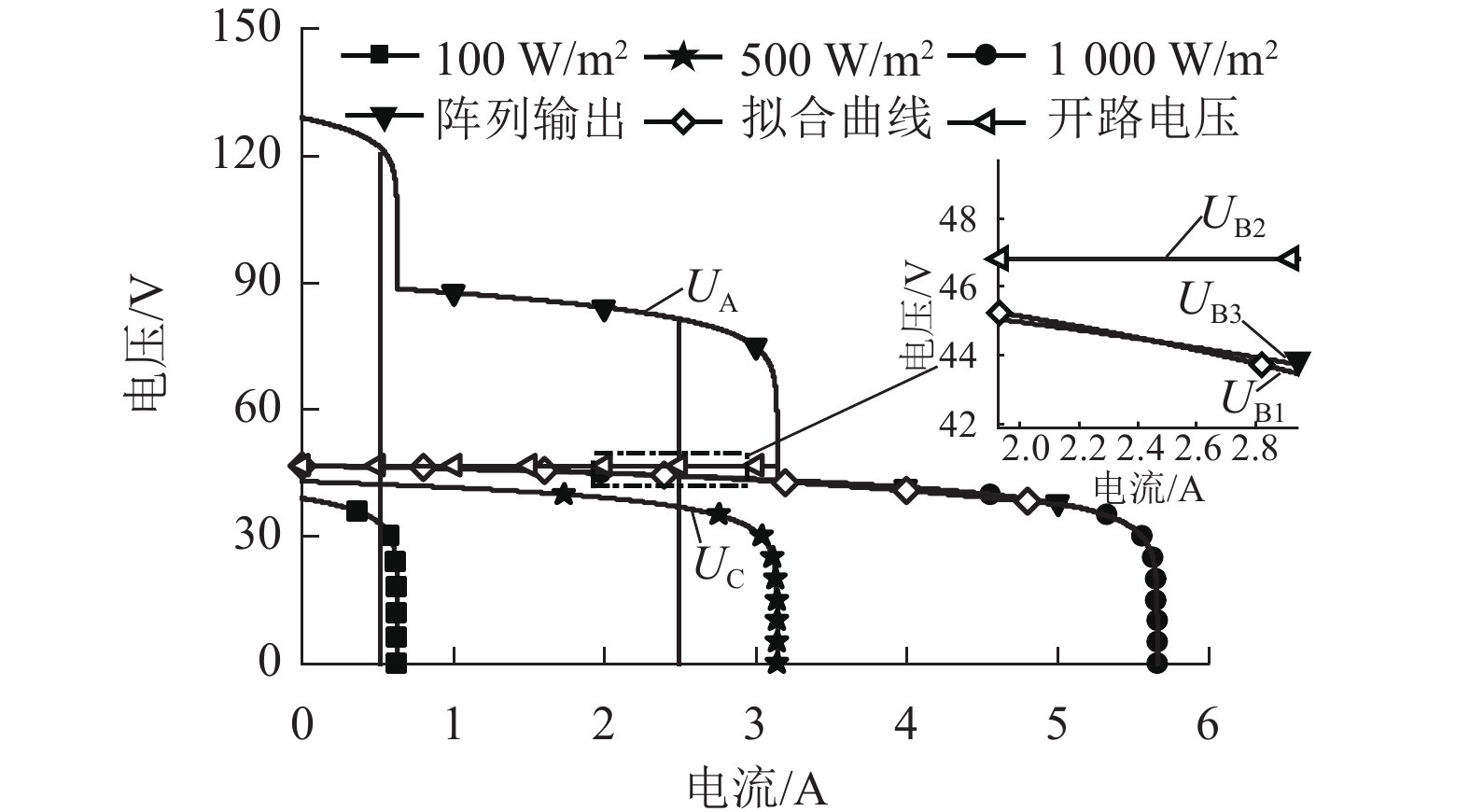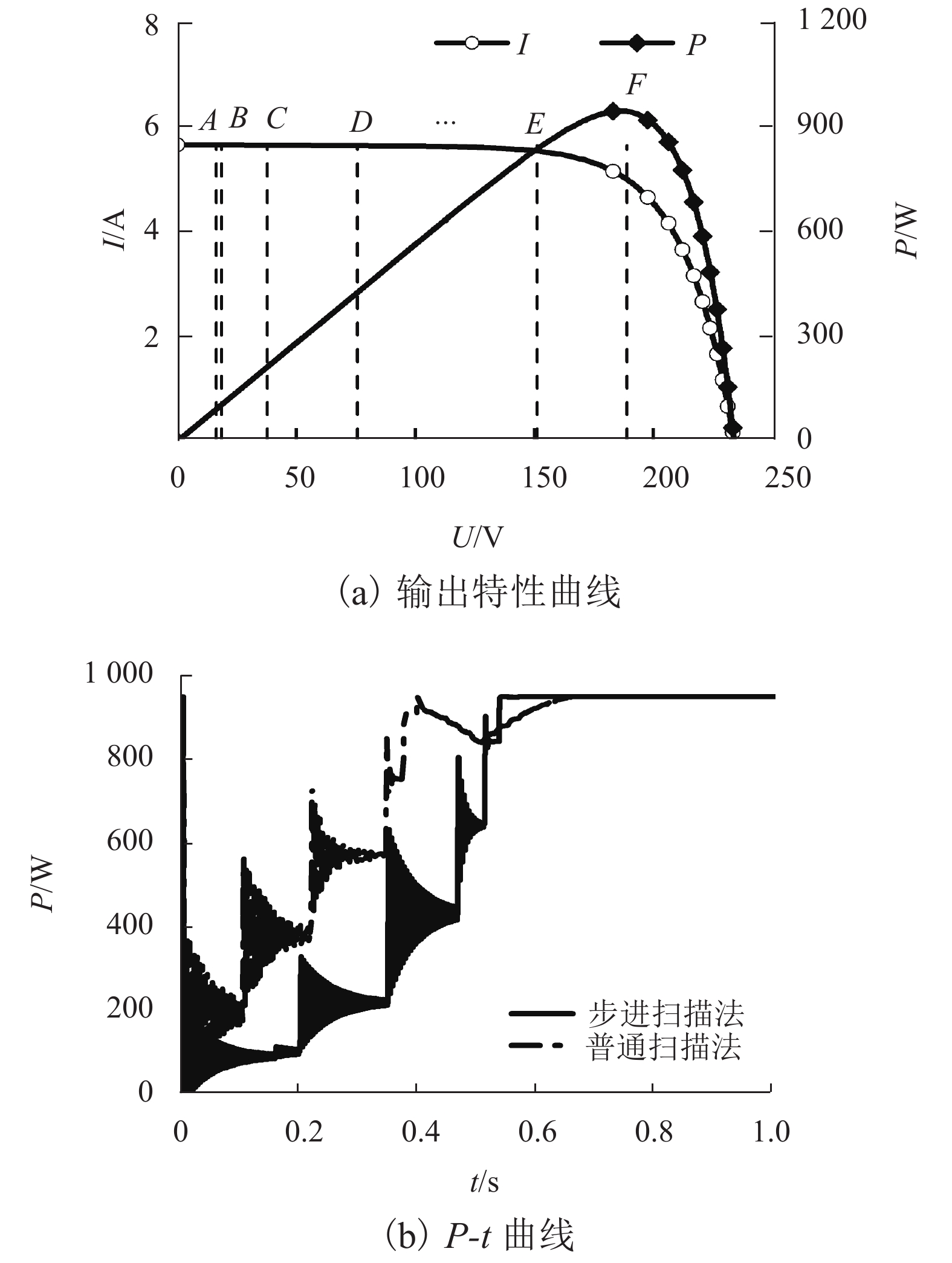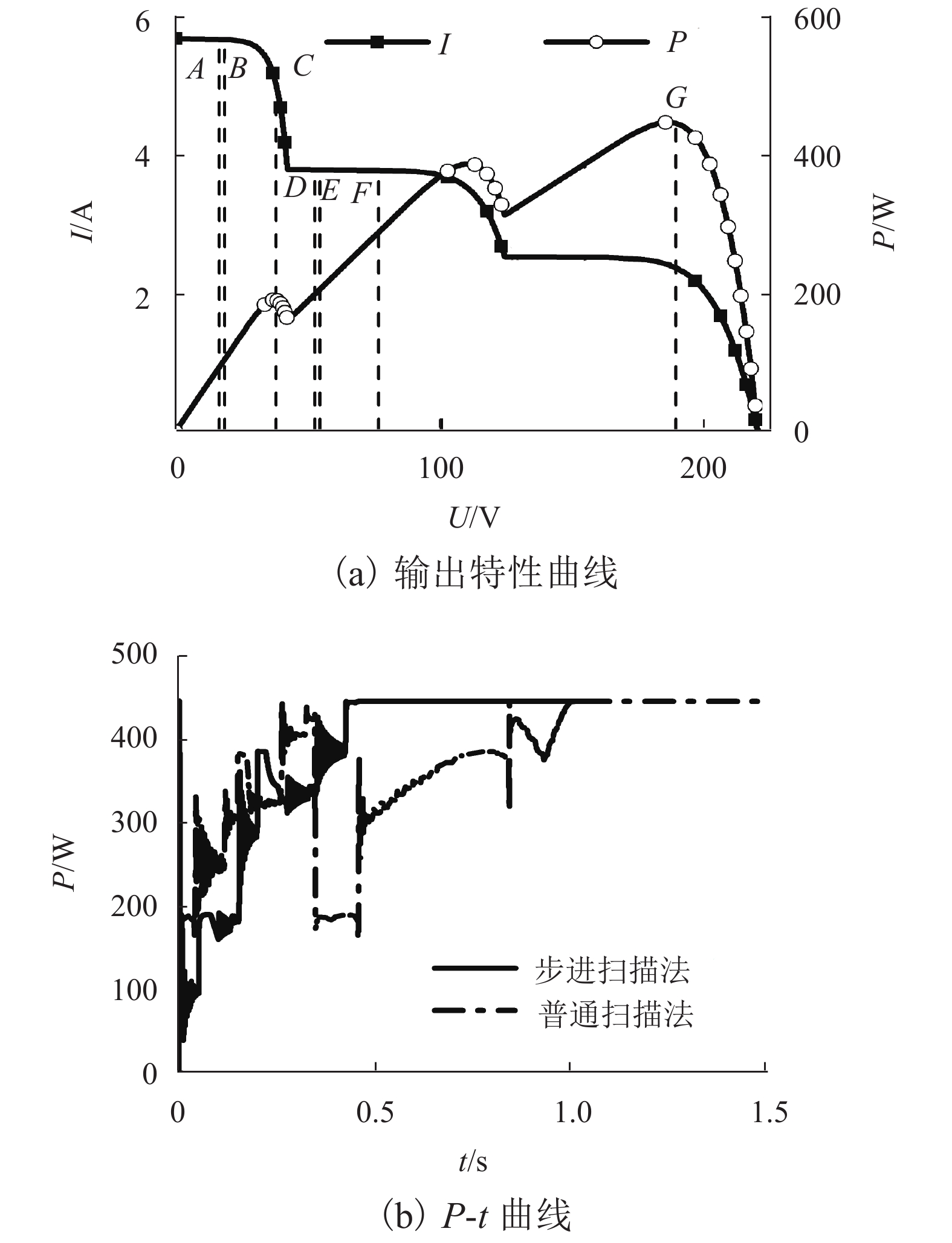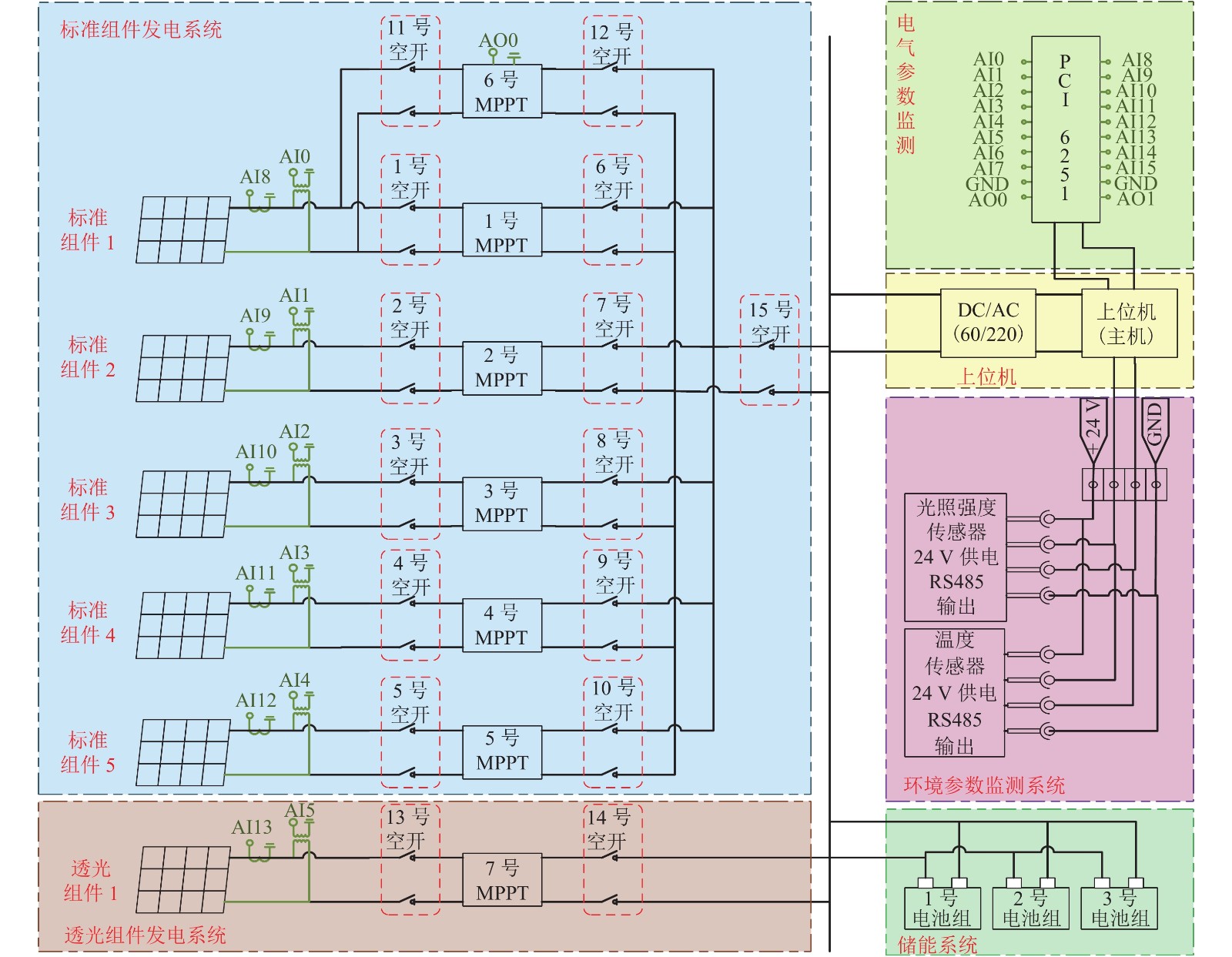Fast Power Tracking Step-Scanning Method of Vehicle-Mounted Photovoltaic System with Moving Shadows
-
摘要: 移动阴影给车载光伏最大功率跟踪(maximum power point tracking,MPPT)带来巨大挑战. 为提高移动阴影遮挡下的功率追踪速度,提出一种新的车载光伏全局最大功率跟踪(global maximum power point tracking,GMPPT)自适应步进扫描方法. 首先,分析温度及辐照强度对光伏单体输出特性的影响规律,基于温度及短路电流预测光伏单体开路电压;其次,基于串联光伏阵列的最大功率点电压与光伏单体输出特性的关系,以及局部阴影条件下多峰曲线峰值点电压和功率的变化特性,提出功率追踪步进扫描的自适应步长求取方法;最后,通过仿真及样车试验对所提算法进行可行性测试和评估. 结果表明:与常规扫描法相比,本算法的追踪速率最高可提升74%,且可避免严重遮挡时无法追踪全局最大功率点的问题.Abstract: Moving shadows bring great challenges to maximum power point tracking (MPPT) of vehicle-mounted photovoltaic power generation systems. In order to improve the speed of MPPT under moving shadow occlusion, a new adaptive step-scanning method for global maximum power point tracking (GMPPT) of vehicle photovoltaic is proposed. Firstly, the influence of temperature and radiation intensity on the output characteristics of photovoltaic cells is analyzed, and the open-circuit voltage of photovoltaic cells based on temperature and short-circuit current are calculated; Then, based on the relationship between the maximum power point voltage of the series photovoltaic arrays, the output characteristics of the photovoltaic cells, and the distribution characteristics of the voltage and power at the peak point of the multimodal curve under local shadow conditions, a method of the adaptively adjusting step size for step-scanning MPPT is proposed. Finally, the feasibility test and evaluation of the proposed algorithm are carried out through simulation and photovoltaic prototype vehicle tests. The results show that, compared with the conventional scanning method, the tracking rate of the proposed algorithm can be increased by up to 74%, and the problem that the global maximum power point cannot be tracked in the case of severe occlusion can be avoided.
-
Key words:
- MPPT /
- vehicle photovoltaic /
- moving shadows /
- step-scanning method /
- adaptive algorithms
-
表 1 HN-214标称参数
Table 1. Nominal parameter of HN-214
参数 峰值功
率 Pm/W开路电
压 Uoc/V短路电
流 Isc/A最大功率点
电压 Um/V最大功率点
电流 Im/A取值 214 47.8 6.29 38.5 5.57 表 2 光伏组件标称参数
Table 2. Nominal parameters of photovoltaic modules
参数 Pm/W Uoc/V Isc/A Um/V Im/A 取值 233 51.7 6.29 41.8 5.57 表 3 两种控制器的控制效果对比
Table 3. Control effect comparison of two controllers
控制器 参数 工况 无遮挡 轻度遮挡 无遮挡 重度遮挡 T = 0~4 s T = 4~8 s T = 8~12 s T = 12~16 s 市场 MPPT Tt/s 2.15 1.49 1.62 0.09 Pm/W 154.6 105.5 152.3 81.4 Em/(W•h) 0.150 0.117 0.169 0.090 Eo/(W•h) 0.097 0.093 0.159 0.028 η/% 64.5 79.3 94.0 31.0 SS-GMPPT Tt/s 0.53 0.71 0.55 0.75 Pm/W 150.6 102.1 149.4 81.4 Em/(W•h) 0.146 0.113 0.166 0.090 Eo/(W•h) 0.138 0.108 0.157 0.083 η/% 94.3 94.9 94.9 91.8 -
陈维荣,王伟颖,郑义斌,等. 局部阴影光伏发电系统中基于改进PSO的MPPT控制[J]. 西南交通大学学报,2018,53(6): 1095-1101. doi: 10.3969/j.issn.0258-2724.2018.06.001CHEN Weiwong, WANG Weiying, ZHENG Yibin, et al. MPPT control of partial shadow photovoltaic generation system based on improved PSO algorithm[J]. Journal of Southwest Jiaotong Unversity, 2018, 53(6): 1095-1101. doi: 10.3969/j.issn.0258-2724.2018.06.001 FEMIA N, PETRONE G, SPAGNUOLO G, et al. Optimization of perturb and observe maximum power point tracking method[J]. IEEE Transactions on Power Electronics, 2005, 20(4): 963-973. doi: 10.1109/TPEL.2005.850975 ISHAQUE K, SALAM Z. A review of maximum power point tracking techniques of PV system for uniform insolation and partial shading condition[J]. Renewable and Sustainable Energy Reviews, 2013, 19(3): 475-488. GUO Lei, MENG Zhuo, SUN Yize, et al. A modified cat swarm optimization based maximum power point tracking method for photovoltaic system under partially shaded condition[J]. Energy, 2018, 144(3): 501-514. 陈明轩,武建文,马速良,等. 复杂遮蔽条件下光伏多峰出力特征及GMPPT控制[J]. 北京航空航天大学学报,2017,43(6): 1141-1148.CHEN Mingxuan, WU Jianwen, MA Suliang, et al. Photovoltaic multi-peak output characteristics and GMPPT control under complex shaded condition[J]. Journal of Beijing University of Aeronautics and Astronautics, 2017, 43(6): 1141-1148. MUTOH N. A method for MPPT control while searching for parameters corresponding to weather conditions for PV generation systems[J]. IEEE Transaction on Industrial Electronics, 2006, 53(4): 1055-1065. doi: 10.1109/TIE.2006.878328 李善寿,张兴,张鸿恺,等. 基于功率闭环控制与PSO算法的全局MPPT方法[J]. 中国电机工程学报,2014,34(28): 4809-4816.LI Shanshou, ZHANG Xing, ZHANG Hongkai, et al. Global MPPT method based on power closed-loop control and PSO algorithm[J]. Proceedings of the CSEE, 2014, 34(28): 4809-4816. 朱艳伟,石新春,但扬清,等. 粒子群优化算法在光伏阵列多峰最大功率点跟踪中的应用[J]. 中国电机工程学报,2012,32(4): 42-48.ZHU Yanwei, SHI Xinchun, DAN Yangqing, et al. Application of PSO algorithm in global MPPT for PV array[J]. Proceedings of the CSEE, 2012, 32(4): 42-48. 李锐,李小谦,邓磊,等. 适应局部阴影条件的单电压采样MPPT技术[J]. 太阳能学报,2018,39(8): 2357-2364.LI Rui, LI Xiaoqian, DENG Lei, et al. Single voltage sampling MPPT technology adapted to local shadow condition[J]. Acta Energiae Solaris Sinica, 2018, 39(8): 2357-2364. NGUYEN T L, LOW K S. A global maximum power point tracking scheme employing DIRECT search algorithm for photovoltaic systems[J]. IEEE Transactions on Industrial Electronics, 2010, 57(10): 3456-3467. doi: 10.1109/TIE.2009.2039450 吕盛华,王磊,任春光,等. 复杂光照条件下串联光伏阵列特性研究及最大功率跟踪[J]. 太阳能学报,2017,38(9): 2329-2336.LYU Shenghua, WANG Lei, REN Chunguang, et al. Study on characteristics of series photovoltaic array and maximum power tracking under complex illumina- tion[J]. Acta Energiae Solaris Sinica, 2017, 38(9): 2329-2336. 张臻,沈辉,李达. 局部阴影遮挡的太阳电池组件输出特性实验研究[J]. 太阳能学报,2012,33(1): 5-12. doi: 10.3969/j.issn.0254-0096.2012.01.002ZHANG Zhen, SHEN Hui, LI Da. Experimental study on characteristics of partial shaded solar module[J]. Acta Energiae Solaris Sinica, 2012, 33(1): 5-12. doi: 10.3969/j.issn.0254-0096.2012.01.002 吴春华,周笛青,李智华,等. 光伏组件热斑诊断及模糊优化控制方法[J]. 中国电机工程学报,2013,33(36): 50-61.WU Chunhua, ZHOU Diqing, LI Zhihua, et al. Hot spot detection and fuzzy optimization control method of PV module[J]. Proceedings of the CSEE, 2013, 33(36): 50-61. 邬明亮,戴朝华,邓惠文,等. 基于单体光伏/单体储能电池模组的新型光伏储能发电系统[J]. 电力系统保护与控制,2017,45(3): 56-61.WU Mingliang, DAI Chaohua, DENG Huiwen, et al. A novel PV energy storage generating system based on single PV cell/single energy storage cell module[J]. Power System Protection and Control, 2017, 45(3): 56-61. -





 下载:
下载:








